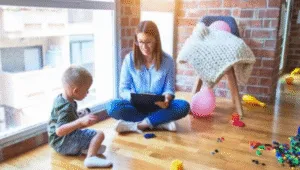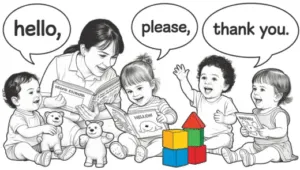Most parents assume that when their child shows a speech delay or language delay, the solution lies in waiting for progress through a typical developmental track. Yet this gap between chronological age and actual language skills often widens precisely because adults hesitate to start implementing speech delay activities before seeking a diagnosis. The fascinating reality, backed by research from the American Speech-Language-Hearing Association (ASHA), reveals that roughly 25 percent of late talkers who can’t use oral language effectively during their 2-year milestone will continue experiencing difficulty with language well into their preschool and elementary years.
What many regular caregivers don’t realize is that speech delay activities can address multiple domains simultaneously, from phonology (how sounds are organized) to pragmatics (social communication), and even semantics (understanding meaning). The difference between simply a delay versus a significant impairment or disorder often hinges on whether kids receive consistent practice through everyday situations before oral-motor problems or comprehending difficulties become deeply entrenched patterns.
Teaching through speech delay activities represents far more than therapy; it’s about recognizing that children learn best when parents become their child’s first teacher, applying techniques throughout the day rather than isolating intervention to clinical settings. Whether your toddlers face trouble understanding due to chronic ear infections affecting one ear, or struggle with articulation because a short frenulum (the fold beneath the tongue) limits tongue movement, the best approach involves encouraging natural speech development through play.
From using colorful board books to foster expressive language, to teaching colors between 18-29 months when brain development peaks for visual concepts, to implementing sign language as a tool that won’t stunt growth but rather offers freedom to express wants and needs, these strategies transform learning into something fun and engaging.
The key isn’t in overwhelming your baby with complex activities, but in keeping things simple: spending time reading, singing children’s songs during routines like taking a bath or eating breakfast, using self-talk to describe what you see and hear while playing with toys, and teaching feelings so young children can cope with emotions rather than becoming frustrated easily. When you put favorable items within sight but out of reach, you create an opportunity for your child to gain attention and practice communication skills by making requests, a technique speech therapists recommend to encourage acquiring new skills through natural motivation rather than forced imitation.

Understanding Speech and Language Delays
When parents notice their baby isn’t hitting expected milestones, the frustrating reality sets in, and communication feels like a puzzle with missing pieces. Speech delay and language delay aren’t interchangeable terms, though they often overlap in young children. Speech refers to the verbal expression of sounds and words, while language encompasses understanding and being understood through verbal, nonverbal, and even written means.
A child might struggle with oral impairment affecting the tongue or palate (the roof of the mouth), making it hard to coordinate the lips and jaw to form clear speech sounds. Others face problems in areas of the brain responsible for speech, where feeding problems or hearing problems silently affect their developing abilities.Chronic infections can limit normal hearing, and without proper audiologist test results, speech concerns may go unaddressed 3 times longer than necessary.
The US reports that roughly 8% of kids experience these communication problems, making early identification through a professional speech-language therapist or online speech therapy for autism crucial for those on the spectrum. Trouble communicating manifests differently across age groups: a 12-month-oldwho isn’t using gestures like pointing or waving bye-bye, or an 18-month-old toddler who prefers gestures over vocalizations to communicate and has trouble imitating sounds or understanding simple verbal requests.
By 3 years, if strangers can only understand 50% of what your child says, or by 4 years old, when that number should jump to 75% but doesn’t, it’s a sign of speech delay. Some children can only imitate speech and actions rather than produce words or phrases spontaneously, while others say only some sounds repeatedly or can’t use oral language beyond immediate needs. An unusual tone of voice, raspy or nasal sounding, combined with speech that’s harder to understand than expected for age, means you should call a doctor right away.
Kids who can’t follow simple directions, don’t respond to their name, or doesn’t produce meaningful language skills need to be checked by a doctor before the intensive period of the first three years of life passes, when babies are practically born ready to learn and acquire speech and acquire language at the expected rate if given a stimulating environment to develop brain connections.

What Leads to Speech or Language Delays?
The underlying reality behind speech delays often traces back to how children process language through both receptive language and expressive language pathways, where difficulties in producing language stem from oral-motor status challenges when the mouth, tongue, and palate fail to work together efficiently during speech, eating, and swallowing. Speech delay activities become essential when children exhibit a slow onset of speech skills compared to age peers, particularly when morphology and syntax development lag behind typical children at a specific rate.
Earlier diagnosis through standardized tests by a speech-language pathologist (SLP) canhelp identify whether a child has a language impairment or simply needs speech therapy activities to bridge the gap, making speech delay activities a preventive measure rather than a reactive intervention inwhole child therapy approaches. Beyond physical acquisition barriers, speech problems and language problems differ yet overlap when brain processing of emotions intersects with communication. Childrenwho struggle to regulate emotions regularly often find it harder to use words or put two words together because emotions are processed on the right side of the brain, creating an overwhelming experience that manifests as cry responses instead of verbal expression of ideas.
Speech therapists recognize that children’s emotions play a vital part in overall development, where frustrated easily might have problems with sound development, not due to a delay in speech development, but because learning new concepts requires attention that’s disrupted when easily distracted or unable to cope with emotionsappropriately.
Speech delay activities integrated with speech therapy activities address this modality’s connection, where they help kids learn that being happy, sad, angry, frustrated, jealous, surprised, or scared doesn’t stunt their child’s development, contrary to outdated beliefs, but instead offers an opportunity for speech-language pathologist interventions that foster communication skills alongside emotional validation.

What’s the Difference Between Speech and Language?
Many health care providers will refer families when they notice that what the child can say doesn’t match what the child understands. Thisdistinction is vital for speech delay activities. Speech involves the physical act of producing sounds and achieving clarity of speech, while language encompasses how we use words to communicate meaning and phrases to express complex ideas. During preschool speech therapy sessions, I’ve observed children who could produce clear words but struggled with the use of language in social contexts with other children, and conversely, kids with excellent comprehension who were simply hard to understand due to articulation issues.
The speech-language therapist will look for milestones in both areas separately, because speech delay activities targeting one domain may not address challenges in the other, and this is where parents often find themselves confused about which concepts need focus. Speech therapy involves work with a child on the mechanics of the mouth actions, tongue placement, and how to speak clearly, while language intervention addresses communication strategies like encouraging imitation of sentence structures, encouraging speech development through play, and teaching what to do when the child wants to communicate effectively.
When implementing speech delay activities at home, it’s important to recognize whether you’re addressing motor planning (can they physically make the sound?) or conceptual understanding (do they know when and why to use that word?). I recommend that families working on speech delay activities understand this split because a child who isn’t talking yet might have strong language skills internally but needs support with the physical use of their mouth and vocal cords, while another might speak clearly but not grasp how you feel or what you hear in conversational exchanges.
The pathologist will diagnose which system needs intervention, ensuring earlier treatment yields better results by targeting the actual breakdown point rather than applying generic approaches.

How to Recognize Speech or Language Delays
When kids struggle with language, the signs often emerge not during formal assessments but through play, daily routines, and everyday moments at the grocery store or while changing clothes. Parents notice their child isn’t using two-word phrases by age two, or that one-word utterances dominate when peers have moved to three-word utterances effortlessly. The inability to name objects around the house, express basic hunger, or request items becomes apparent during speech delay activities like reading books together.
Unlike typical development, where a child’s speech naturally progresses from chunking sounds to speaking clear phrases, a delayed child’s language shows gaps, difficulty with gestures, limited vocalization, or struggles to learn new concepts even when caregivers consistently teach through self-talk and repetition. What’s fascinating is how these signs manifest during speech delay activities designed to help a kid might squirm during reading time, avoid eye contact when you ask questions, or fail to anticipate sounds of animals in picture books, revealing that understanding hasn’t developed at the expected pace for their months or years of age.
Speech delay activities expose another layer: children who can’t express feelings, functionally use basic sign language to communicate, or engage when teaching colors like yellow, red, green, and blue through coloring books and colorful blocks. The problem isn’t always obvious. Some children talk but keep utterances short and simple, beyond what’s age-appropriate, never building complex language skills despite constant exposure. During speech delay activities like singing nursery rhymes or playing with animal toys, you notice they don’t imitate, can’t generalize words across contexts, or seem frustrated trying to express wants and needs.
Rather than learning through natural interaction, they need therapy activities that optimize their learning by breaking down communication skills into manageable steps, whether that’s teaching sign language basics to give them a way to communicate before they can start talking, or encouraging them to push beyond current abilities by placing favorable toys out of reach to gain attention and practice requesting. These aren’t just developmental quirks; they’re indicators that overall development needs targeted help to improve cognitive skills, problem-solving skills, and social interaction that typically emerge naturally through spending time in outdoor environments, listening to stories, and experiencing the world around them.

What Can Parents Do? / Home-Based Activities
Most families call doctor offices with concerns about speech delay activities without realizing the groundwork they can lay before formal intervention begins. The truth is, treating communication gaps isn’t exclusively clinical; what you do in everyday moments matters more than scheduled exercises. When you show genuine curiosity about your toddler’s babbling attempts rather than correcting them, you’re already engaging in speech delay activities that professionals would endorse. The key distinction many miss: early on, it’s less about drilling vocabulary and more about creating low-pressure environments where vocalization feels rewarding rather than performative.
Think about how you respond when your child points. Do you immediately supply the word, or do you pause, giving them space to attempt it themselves? That hesitation, counterintuitive as it feels, teaches them their voice has power. Here’s what specialists rarely emphasize about speech delay activities: they’re not separate from daily life but woven into it. You don’t need flashcards to help a child’s language development. Narratingyour grocery store choices, singing off-key during bath time, or exaggerating facial expressions while reading create natural speech delay activities that improve the connection between sound and meaning.
I’ve watched parents transform simple routines by adding strategic pauses, letting silence do the heavy lifting instead of rushing to fill it. Know that repetition without pressure builds neural pathways more effectively than forced practice sessions. When you show excitement about their attempts rather than their accuracy, you’re validating the process itself. The hidden advantage of home-based speech delay activities is authenticity—children respond to contexts where communication serves real purposes, whether that’s requesting a snack or protesting bedtime, rather than abstract drills disconnected from their immediate world.
What’s Involved in Diagnosing Speech or Language Delays?
When professionals assess whether speech delay activities are needed, they’ll look at how your child attempts to talk and whether they use gestures to request items or promote social interaction, essentially observing if your child’s learning follows typical patterns or if they don’t need many prompts to begin expressing needs. The caregiver might be asked to describe daily scenarios: does your child naturally label toys during play, encourage turn-taking, or spend time trying to name foods at meals, because these seemingly small moments reveal whether speech delay activities should start immediately.
Diagnosticians often ask parents to demonstrate how they currently talk through routines, whether they keep things simple or already teach advanced concepts, since understanding your baseline helps determine if structured speech delay activities will foster ability effectively or if adjustments to home strategies come first. The evaluation isn’t just clinical observation; it’s about understanding the overall developmental picture, so expect questions about whether your child can stay put for the duration of simple tasks, deal with frustration when things are out of reach, or create sequences during imaginative play using open-ended toys that can be played many ways.
Professionals might place items in clear bins on shelves where children see items but can’t get them independently, watching if they naturally push toward communication or remain passive. This strategy reveals if immediate speech delay activities become the priority or if sensory and motor foundations need addressing first. They’ll explain findings without baby talk, helping you understand the next steps, whether that means weekly therapy sessions lasting 30 minutes to an hour or embedding activities throughout your day that promote creativity and offer your child structured ways to practice new communication skills.
Conclusion
Learning through repetition is the key to mastery. Don’tbe afraid to repeat the same words many times while talking about what you are doing, whether cooking a meal, cleaning a room, or spending time outdoors with your baby, as this technique used throughout everyday activities naturally encourages speech.
When you speak to child in phrases of same length or slightly longer than theirs, using one word when they’re beginning or few two-word phrases together as they advance, you promote bonding while helping them learn through fun way interactions reading book sessions where you leave out words they can fill in, singing songs that activate senses, using play dough to introduce concepts, teach sign language alongside verbal tips, and categorizing same colored objects to learn colors sooner.
Each experience becomes an opportunity to build confidence, increase attention, and allow your child to learn new concepts while maintaining joy and mental health in the journey.
FAQs
Q: Should I wait until my toddler shows readiness before I start teaching colors or teach sign language? Many parents avoid early communication work, but teach concepts when they’re repeated daily, starting with basics like balls and snacks to encourage requesting preferred items rather than giving unlimited access to everything on shelves or behind cabinet doors.
Q: Is it okay to use toys properly as the only way to promote speech development?
All toys serve a role, but children learn how to speak through varied experiences, read books, sing songs, dance, and move to music during great times together, since learns new concepts happens when you bond through upbeat activities that match their general mood rather than just entertaining children with objects.
Q: When teaching a child new vocabulary, should I use everyday items or special materials?
Choose what’s already in your environment as great opportunities emerge naturally—when performing routines, talk about actions like “push car” or “I can bounce ball” with descriptive words like “round” or “blue,” letting them experience touch, smell, and visual input while hearing you talk through all of this sensory engagement.
Q: My child is using mostly single words—should I tell them full sentences or match their level?
The general rule of thumb is modeling more words than they produce—if they’re at the beginning stage speaking in phrases or using few one-word utterances, you can put together a “lot of two-word phrases” like “this is ball” or “I like to play with ball,” then throw in simple expansions that are easily anticipated rather than complex explanations.
Q: Can books really help if my child doesn’t seem interested or won’t sit still?
Soft books offer tactile exploration that introduce vocabulary beyond traditional reading—next time, try the Rainbow song or Color Song with same colored objects during play, using book content to teach through memory and repeat exposure so they maintain and generalize language skills, turning an unforgettable situation into a proven method where imaginative skills emerge while they feel engaged rather than pressured,allowing youto educate without forcing seated time, which is often the best gift you can give tool for development even when they seem to “not learn” conventionally—all of those things about same vocalization and other colors will click when presented through better multisensory approaches where they love the process, and “ops, what is that thug” becomes their natural idea to explore
